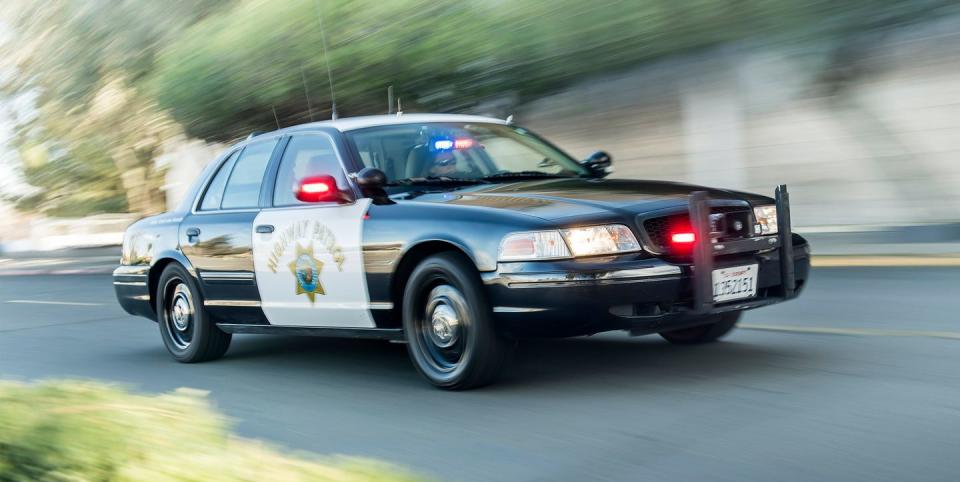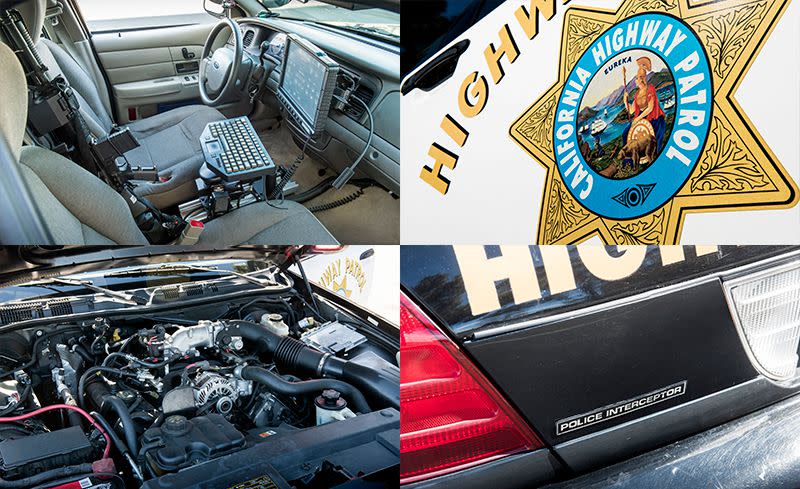The Great Panther Extinction: This Is One of the Last Crown Vic Cop Cars in

From the June 2018 issue
During a recent stop at the Shell station in Mojave, we spotted two shiny, new California Highway Patrol Dodge Chargers gleaming in the sun. Inside the well-worn mini-mart, the two cops assigned to the Dodges were contemplating the relative virtues of Pure Leaf and Gold Peak iced teas. We interrupted the armed and armored officers to ask a hard-hitting question: “How do you guys like the Charger?”
“Uh,” one said as the other nodded sagely, “it’s okay. But it’s no Crown Vic.”
We were surprised. The Charger looks good in police livery, and it is relatively new, certainly compared with the ancient Ford Crown Victoria. Didn’t Ford stop making those almost a decade ago? Why are police officers pining for them? Are there still Crown Vic cop cars on the road?

Fast forward two months. After a few phone calls to the CHP, we’re in the parking lot of its North Sacramento office, where Officer Amy Walker brings out Unit 2151 for us to experience. It’s one of the last Crown Victoria Police Interceptors still in service with the agency. Out of a total fleet of approximately 2965 patrol vehicles, Crown Vics now number only about 200. Showing just 63,952.4 miles on its odometer, Unit 2151 is, the CHP avows, the lowest-mileage Crown Vic in its fleet. And at the rate it’s racking up miles, it’s likely to be the last one retired.
In September 2010, it left Ford’s St. Thomas, Ontario, assembly plant and headed to CHP Fleet Operations in Sacramento. The CHP paid $22,660 for it, as Ford (through a local dealer) had submitted the low bid for patrol cars that year. The car was painted black, but the dealer sprayed white paint onto the front doors and roof. Push bars, flashing lights, and a siren were bolted on. There’s a rack of radio equipment in the trunk, and the CHP’s graphic door stickers completed the transformation. Iconic? Close enough.
There are some 18,000 separate police agencies in the United States, and the Crown Vic, built atop FoMoCo’s Panther platform, served with virtually all of them over its 33-year production run. And likely all of Canada’s, too. Plus some of Mexico’s, Saudi Arabia’s, and those of several other countries in the Middle East. For a few years, Panthers patrolled the mean streets of Moscow, Idaho, and Moscow, Russia.

Once General Motors stopped production of the Chevrolet Caprice 9C1 police car in 1996, the Crown Vic was basically alone in the cop-car market, a position it then enjoyed for 15 years. Ford produced the last Crown Victoria on September 15, 2011, almost a year after Unit 2151 rolled off the St. Thomas line. The Police Interceptor’s most important advantage wasn’t its performance or image, but the fact that Ford had been producing the things for so long that it could build them inexpensively. The CHP, like most law enforcement agencies, buys the vehicle that meets its performance parameters at the lowest price.
“Now that looks like a cop car,” Walker says with a determinedly cheerful lilt in her voice. Mixed in among the Ford Explorers that the CHP adopted as its immediate replacement (“Police Interceptor Utilities” in cop-speak), the Crown Vic stands out as a badass. On our ridealong, we’d be 46-David-5 for the day. “We don’t have a patrol area,” the 19-year CHP veteran tells us. “So we can go pretty much wherever we want.”
If anything, the Panther-platform cars were agonizingly ordinary when they made their debut for the 1979 model year. After the wallowing full-size horrors of the ’70s, the supersquare LTD sedan (later renamed Crown Victoria) seemed trim at 209.0 inches over a 114.4-inch wheelbase, but its manners were as ponderous as those of the flabby barge it replaced. “The new [Panther-based LTD] seems a bit smaller than the old model, but no lighter. And considering that almost all of the parts are different,” we wrote upon our initial encounter, “the family resemblance is uncanny. Both have tremendous isolation from road shock. Both are quiet, soft-riding, and limousine-like. Not surprisingly, both are of body-and-frame construction with plenty of rubber isolation . . . and both give absolutely no feel of the road through the controls.”
The first Panthers had one notable virtue, a feature that became much prized by the law enforcement community. “Then there is the trunk,” we wrote, “a compartment so cavernous you expect to be greeted by bats.”
Walker has 2151 lollygagging in the left lane at about 70 mph, the car floating across I-80. The windows of a Ford Mustang drop down as we come up behind it. “The windows are tinted illegally,” Walker tells us. “No one drives with their windows down on the freeway unless they’re hiding a tint.”
Past the Mustang is a Buick Rendezvous stopped on the shoulder with its flashers on. “Let’s see what’s going on,” Walker says, though we regard parked-on-the-shoulder as the now natural state of any remaining Rendezvous. Walker pulls over and gets out to approach the crusty Buick while we stay in 2151. “She says it’s overheating,” Walker reports, getting back into the driver’s seat. “I told her to move it off the freeway.”
As the Rendezvous steams off, Walker puts 2151’s column-mounted shifter into drive. “This is what I’ve missed since I got a Charger,” she says and nails the accelerator. The Ford lurches forward and is quickly back up to freeway speed. Its SOHC 4.6-liter V-8 was rated at only 250 horses in 2011, but it makes good low-end torque with a peak of 297 pound-feet. And all but 12 of the CHP’s new Chargers are V-6s. “It’s all coming back to me,” Walker continues. “It feels right.”

It’s easy to get comfortable in 2151. The front seats are more squishy than supportive, but there’s elbowroom to spare. The Charger lacks this sort of stretch-out space. Most of the Crown Vic’s plastic interior panels are atrociously cheap-looking, but what does that matter? This is an easygoing, comfortable workplace. And that does matter.
“Look at that island,” Walker says as she points at the median separating opposing lanes of traffic on a boulevard heading into Rancho Cordova. “With the Crown Vic, it’s easy to go right over that and head back the other way. And we do that all the time. Nothing hangs below the car so there’s nothing to get damaged.”
“The car evolved,” explains Ed Nalodka, who did a couple of stints as Panther vehicle engineering manager for Ford. “There were people who worked on Panther for most of their careers because they liked working on Panther. They were familiar with its past performance capabilities, and they kept pushing the car and pushing the car.”

The Crown Vic saw its biggest evolutionary change with the 1992 model year, when Ford replaced the box atop the chassis with a new Taurus-like body. That was when it also ditched the LTD name entirely, canceled the civilian station-wagon version, and replaced the overhead-valve 4.9- and 5.8-liter engines with the overhead-cam 4.6-liter V-8. Revisions to the solid-axle rear suspension included the addition of a new anti-roll bar.
For the 1998 model year, the Crown Vic began sharing the Grand Marquis’s body, and Ford started to shift the focus of this car’s development toward the needs of fleet customers such as police departments and taxi operators. Appealing to retail buyers was still important, but what was good for consumers was also good for cops and cabbies. And vice versa. “They came out with rack-and-pinion [for 2003], and that really changed the handling of the car,” explains Dean Bogios, a retired CHP sergeant who still works with the agency’s academy on driver training. “That’s when we started a [Crown Vic] high-speed training fleet. Those cars just kept going and going. They loosened up, but they kept on going and going. We just got rid of them in 2016.”
There’s no way of knowing precisely which Crown Vic with which agency will be the last one to retire. But seven years is incredibly old for a cop car. No CHP cruiser is babied, but they don’t all get the same assignments. Out in a desert county, such as Inyo or Riverside, a unit can rack up several hundred miles a day because of the long distances. But 2151 has spent its life in North Sacramento, mostly patrolling surface streets, and the mileage has accumulated slowly.
The Nevada Highway Patrol retired its last Crown Vic this past August, and local news outlets have been reporting whenever an agency’s fleet retires its last one. It seems that the final Crown Victoria Police Interceptor delivered to a U.S. agency never went on duty but is preserved in the Kansas Highway Patrol’s museum.
Beyond all the cops who drove them and all the people who designed and built them at Ford, the Crown Victoria Police Interceptor has been a part of all our lives. For decades it meant the law was nearby. We memorized its distinctive headlight pattern so we could spot one coming up behind us on a highway. Seeing one on a dark street could be comforting, and the desperate moments spent riding in the back of one with your hands cuffed were usually memorable. Shorthand for civil disorder in this country is an overturned Crown Vic on fire. Many television shows and movies put their make-believe cops in real Crown Victorias.
At the end of our pretend shift, Walker pulls into the North Sacramento office’s parking lot. We get out and stand around the car. Unit 2151 may have a couple more years in it, but it will eventually reach its end, between 100,000 and 150,000 miles, and, like all CHP cars, be decommissioned. Most used-up police cars are auctioned off, purchased by cab companies, and run until their body mounts turn to dust and their spent husks are fed to a metal shredder. This one deserves better. It won’t enter retirement with a speech from the governor, but it’s worthy of enshrinement in the CHP Academy administration building’s lobby alongside the ’66 Dodge Polara squad car that’s already there.
You Might Also Like

 Yahoo Finance
Yahoo Finance 